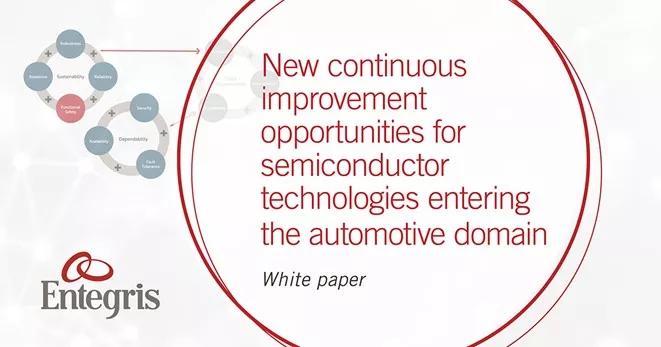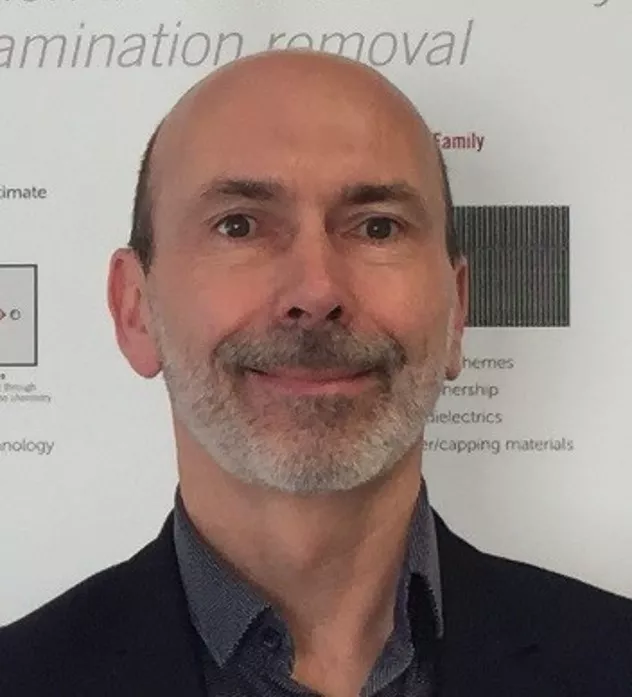
Powered by semiconductor innovation, digital transformation is picking up speed, with semiconductor sales expected to more than double to $1.2 trillion by 2030, fueled by continuing advances in Internet of Things (IoT), artificial intelligence (AI), machine learning, electrification, 6G, and quantum computing, and other technologies. In the automotive industry, innovation hinges on the development of unique architectures, novel materials, and deepening collaboration among semiconductor manufacturers.
SEMI spoke with Antoine Amade, Vice President of sales for the Microcontamination Control division in EMEA and North America at Entegris, about new innovation opportunities for semiconductor technologies entering the automotive domain. Amade shared his views on bridging the gap between semiconductor design and process engineering, and on collaboration between the semiconductor and automotive industries, in order to help advance semiconductor manufacturing for automotive devices. Download the Entegris white paper for more insights.
SEMI: Why is it so important for semiconductor players to collaborate to drive automotive innovation?
Amade: If we want to drive innovations at the pace of new technologies, all members of the semiconductor ecosystem need to assess their strengths and collaboratively plan for success.
 In the past, innovation plans were developed starting from industry standards applied in semiconductor manufacturing. However, these standards were developed solely with consumer electronics in mind, not products that are intended to be 100% reliable over a 15-year lifespan, like autonomous vehicles. This means that although the standards were robust, they did not meet the strict targets demanded by the automotive market. As such, today different members of the semiconductor ecosystem find themselves wondering if they are underperforming or overperforming based on the needs of a new customer.
In the past, innovation plans were developed starting from industry standards applied in semiconductor manufacturing. However, these standards were developed solely with consumer electronics in mind, not products that are intended to be 100% reliable over a 15-year lifespan, like autonomous vehicles. This means that although the standards were robust, they did not meet the strict targets demanded by the automotive market. As such, today different members of the semiconductor ecosystem find themselves wondering if they are underperforming or overperforming based on the needs of a new customer.
SEMI: What is the most pressing next step for the semiconductor industry players to pursue this goal?
Amade: To build greater clarity into the ecosystem, Entegris proposes an interdisciplinary approach that includes design and process engineering teams to better understand the entire process of creating a new semiconductor device. This approach can reduce:
- the number of critical, killer defects
- the design effort to detect and then re-design a device to compensate for any design features that were not detected before or during the manufacturing process
The ultimate goal is to bridge the gap between design and process engineering in order to infer best practices for automotive-related semiconductor manufacturing.
SEMI: Can the automotive industry overcome these challenges on its own?
Amade: As end devices move toward greater electrification and automation, sustainability of the electronics ecosystem, including the robustness, resilience, reliability, and functional safety are all concerns of automakers. Functional safety, defined by ISO 26262 as the “absence of unreasonable risk due to hazards caused by malfunctioning behavior or electrical/electronic systems,” is of upmost importance, as best described by a 0 ppb failure rate requirement. Protecting drivers against unintended system deviations goes well beyond the standard practices of routine testing, software simulations, and electronic system modeling.
Now more than ever, automakers must also dig deeper into their supply chains to identify and eliminate the root causes of potential hazards, some of which are created during the manufacture of the semiconductors that build the systems that drivers rely on. To truly address functional safety, it is essential that the automotive industry and semiconductor manufacturers look at quality assurance together to create frameworks, such as the SEMI Global Automotive Advisory Council (GAAC), that improve functional safety for all stakeholders.

SEMI: What approach do you think is imperative for reducing defect rates?
Amade: By examining the effort/cost for effective defectivity management, including contamination control, members of the semiconductor ecosystem can weigh continuous improvement opportunities against effort/cost for resilient design and test strategies. This balanced approach creates a framework that systematically identifies the optimization potential for critical areas where killer defects and reliability failures are simply undetectable. By creating this framework on known technologies, the semiconductor industry can apply a systematic approach to future architectures and novel materials in order to quickly bring them in line with yield and reliability expectations.
SEMI: What has Entegris been doing to drive improvements in automotive electronics?
Amade: Entegris and Volkswagen collaborated on a jointly white paper, New Continuous Improvement Opportunities for Semiconductor Technologies Entering the Automotive Domain, to illustrate anonymized case studies and fab benchmarks to bridge the gap between design and process engineering that enable best practices for automotive-related semiconductor manufacturing. I would like to thank the co-authors of the paper; Andreas Aal, System Architect of Scalable Compute Platforms at CARIAD SE, a Volkswagen group company; Jennifer Braggin, Director of Technical Training at Entegris; and Mark Puttock, Sr. Director of Advanced Technology Engagements of Entegris for their kind contributions to this project.
SEMI: What are your plans in the coming years to improve collaboration?
Amade: Entegris is planning to improve and widen collaboration along the semiconductor supply chain, and is open to a collaborative approach to help automakers and semiconductor manufacturers identify potential contamination areas and design strategies to address them before they result in latent defects. The final goal will be for us to reduce the burden on inspection and testing, and the risk to the consumer.
By coming together and identifying the most important areas for contamination control, we can collectively identify opportunities for increasing functional safety, greatly benefiting all stakeholders.
 Antoine Amade joined Entegris in 1995 as an application engineer in its semiconductor business. Today, he is the VP of sales for the Microcontamination Control division focused primarily on growing the semiconductor business in North America, Europe and the Middle East through market strategies and sales management.
Antoine Amade joined Entegris in 1995 as an application engineer in its semiconductor business. Today, he is the VP of sales for the Microcontamination Control division focused primarily on growing the semiconductor business in North America, Europe and the Middle East through market strategies and sales management.
Mr. Amade has a degree in Chemical Engineering from ENS Chimie Lille and is a member of the SEMI Electronic Materials Group, the Global Automotive Advisory Council for Europe (GAAC) and the Platform for Automotive Semiconductor Requirements Along the Supply Chain (PASRASC).
Serena Brischetto is director of Marketing and Event Operations at SEMI Europe.